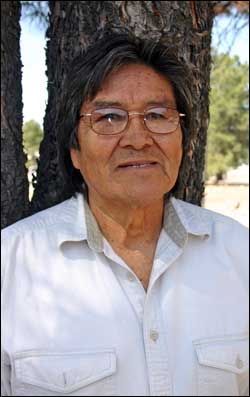When Ferrell Secakuku was a boy growing up on the Hopi reservation, his elders encouraged him to get a modern education as a way to preserve his tribe’s culture. Now Secakuku, 68, is graduating from Northern Arizona University with a master’s degree in anthropology to do just that.
“As an anthropologist my aim is to preserve the value of the Hopi life and to help record traditions so they may pass to future generations,” Secakuku said. “I’m really concerned that our culture is dying away because our young people are not learning our traditions and language.”
Secakuku is one of 2,600 students to graduate this week during four commencement ceremonies at 10 a.m. and 3 p.m. March 12 and 13 in the J. Lawrence Walkup Skydome on the university campus.
Secakuku, a member of the Hopi Snake Clan and Hopi Tribal chairman from 1994-1997, received his bachelor of science degree from NAU in 1964 and decided to pursue a master’s in anthropology to not only help safeguard his experiences, but “to develop formal research skills to use when investigating the Snake Clan, religion and societal roots,” he said.
Secakuku’s research at NAU confirmed his beliefs that Hopi cultural roots, especially Snake Clan ceremonies, took shape in Mexico. His thesis: “Hopi and Quetzalcoatl: Is there a Connection?” explores the connection of Mesoamerican linguistic and religious ceremonies with Hopi history.
“While working on my degree I had the opportunity to travel down to Mexico with my professor, Dr.Miguel Vasquez. I saw many similarities of the Snake Clan culture at the Teotihuacan pyramid,” Secakuku said. “The pyramid was built around A.D. 200 to honor the serpent Quetzalcoatl—a symbol of power and religious ritual in that area. I believe the Hopi brought that religion from there. We still practice it today.”
Secakuku notes other commonalities among the Hopi and Mesoamerican cultures, including language connections and the belief that the Maya and Aztec also emerged from an underworld to this world. He is currently writing grants to fund further research.
“It’s very amazing to discover some of these similarities that I have come across. It really goes to show we must have shared life together at one time,” Secakuku said.
Secakuku, born and raised in the village of Sipaulovi, is a businessman, a farmer, a fine art painter and a Hopi elder who prepares his clan’s religious ceremonies. He speaks about his life to students at NAU and community events. He’s cultivating a nonprofit business, Mesa Media, Inc., to produce and market Hopi teaching language CDs and DVDs, and he is looking forward to graduation so he can spend more time at home.
“I’ve been working on my degree for two and a half years. The only time I’ve left Hopi was for educational purposes. At first, it was very foreign being here. I was away from the Kiva, the planting of corn, and I had to learn how to really read and write,” Secakuku said. “Now I am ready to write about what I know so it will be remembered.”
Chris Downum, an associate professor in anthropology, said, “Ferrell’s thesis defense was historically important not just for NAU but for the discipline of anthropology. It marks the transformation of Hopi as subject to Hopi as scholar and expert. Non-Hopi anthropologists have taken so much from the Hopi over the past century, it was very gratifying to see Ferrell find his voice as an anthropologist and tell his part of the Hopi story in his own words.”



